South Bank at Quarry Trails
- 91 units available
- Studio • 1 bed • 2 bed • 3 bed
- Amenities
In unit laundry, Patio / balcony, Granite counters, Pet friendly, Stainless steel, Walk in closets + more

Need flexibility before your lease ends? Subletting allows you to legally rent out your apartment so you don’t get stuck paying for an empty space.
Life changes fast. A job move, travel plans, or a roommate leaving, the only hiccup is that you’re legally bound to a 12-month apartment lease. You may have heard of subleasing before, but you're not sure what it is, or whether it's a good option for you.
TL;DR Subletting lets another renter step in and cover your lease so you don’t get stuck paying for space you’re not using. Done legally, it can save money and stress if you follow the rules. \
Subletting is when you rent out all or part of your apartment to another person (the subtenant) while your name stays on the original lease. People sublet for many reasons: from study abroad programs and relocating for work, replacing a roommate, to extended travel or short-term financial challenges.
Unlike a lease reassignment or reletting, subletting keeps you legally responsible for rent and damages but offers flexibility without paying early termination fees. In practice, the subtenant takes over day-to-day responsibilities – like paying rent and maintaining the space – while you stay on record as the primary tenant. To do it legally, you’ll need your landlord’s written approval, a signed sublease agreement, and compliance with local rental laws.
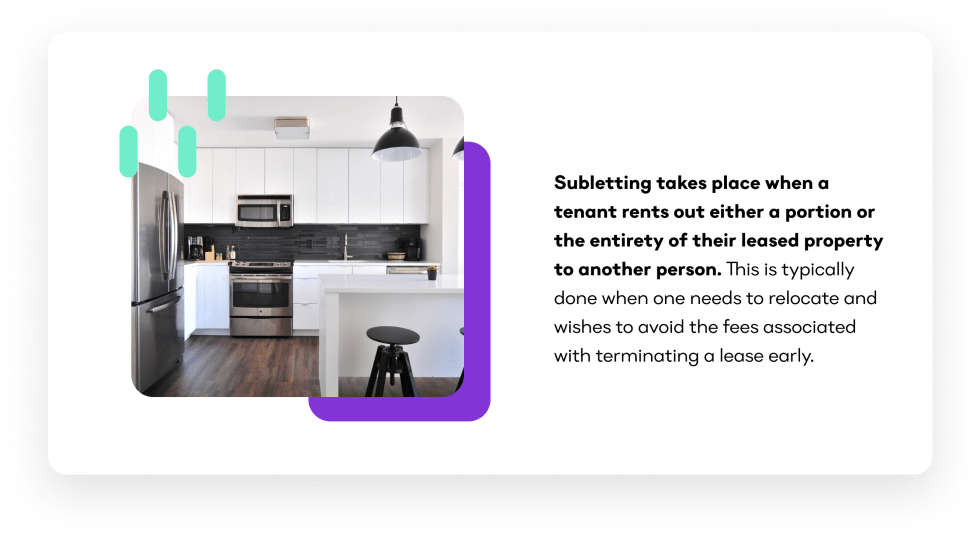
While it’s tempting to offer up a sublease to an acquaintance and shake on it, there are legal requirements to meet, and you’ll also need your landlord's approval. Here are nine tips for subletting legally and successfully.
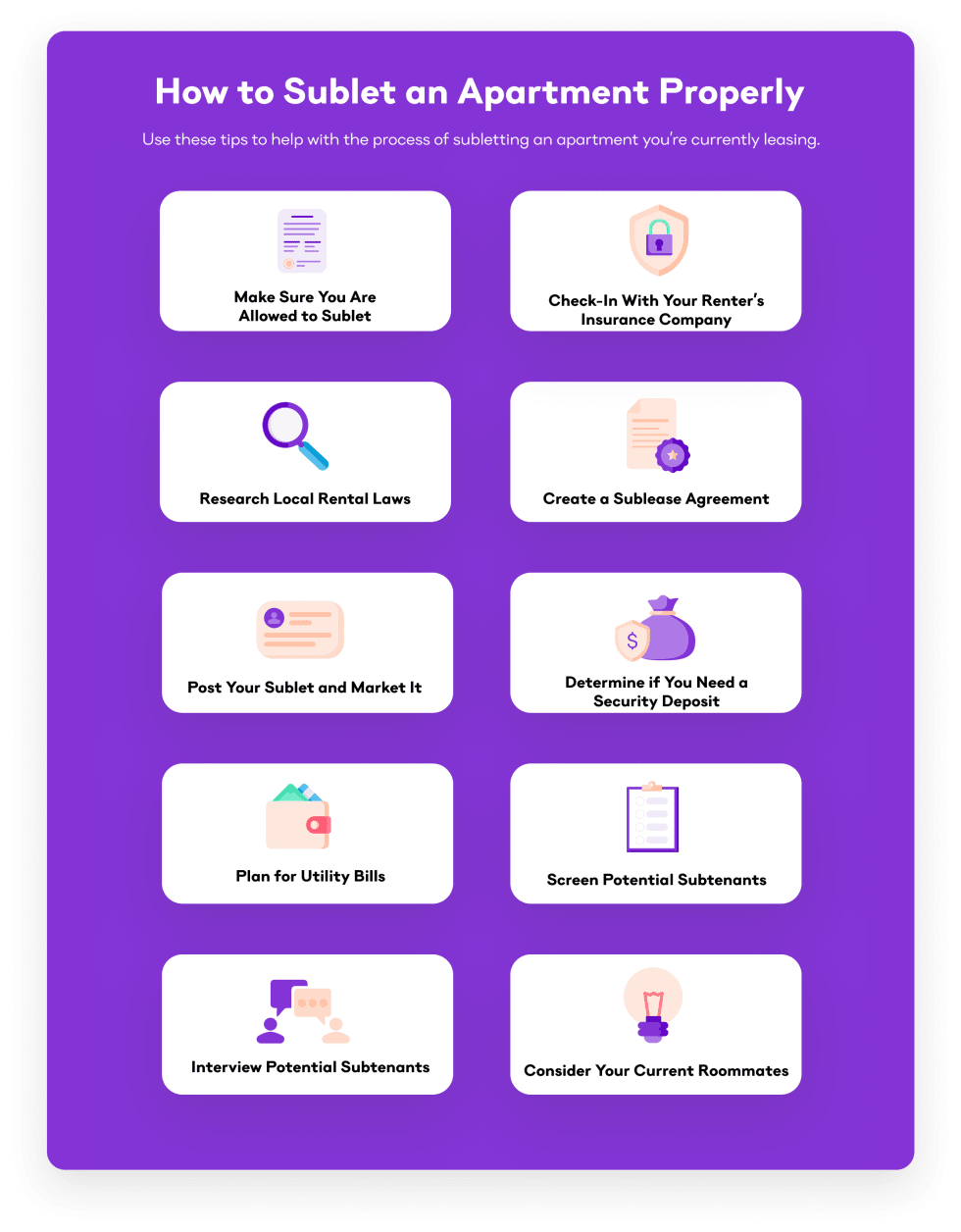
Check if your lease has a subletting clause. Some leases ban subletting outright, while others require written approval. Local laws also matter; in cities like New York and San Francisco, you may need landlord consent or face limits on how much you can charge. If you’re unsure, ask your landlord or look up your state’s rental statutes before moving forward. Check also for any subletting or reletting fees, which landlords may charge to cover paperwork or finding a new tenant
Note: In cases including military and active duty requirements, you may be entitled to break your lease without penalty and skip subleasing altogether.
Even if subletting is allowed, you’ll need written permission. An email or certified letter should include your intent to sublet, the subtenant’s name, the proposed sublease term, and your contact information. This creates a paper trail that protects you if there are disputes later.
Your renter's insurance may stipulate whether you are covered for damage caused by a sublet. If you're not, you should request the subletter to carry their own renter’s insurance. Otherwise, you could be liable for any damage caused during your sublease agreement.
A handshake deal isn’t enough. A sublease agreement should outline the terms between you (the original tenant) and your subtenant. It doesn’t replace your original lease – you’re still responsible for it – but it protects both parties by setting clear expectations.
Subletting apartments in competitive markets, like New York or San Francisco, aren't hard to find. Start by asking your own network if they know if someone is looking to take over a lease. Otherwise, post your sublet and market it through vetted apartment rental sites, social media, or even college student newspapers.
Nine Great Websites for Apartment Subleasing
You’re still liable for rent and damages, so don’t skip vetting. Run a credit or background check, ask for references, and confirm employment. Some landlords will handle this step themselves, but if not, use an online screening service.
Decide whether rent will be paid to you or directly to the landlord. Put it in writing to avoid confusion. Do the same with utility bills. Who’s paying for electricity, internet, and water during the sublease period? Collecting a security deposit is also advisable since it will cover you if the subtenant misses payments or damages the unit.
Before finalizing the sublet agreement, do a walkthrough with your subtenant before move-in and at move-out, documenting the unit’s condition with photos and a detailed inventory list. This helps fairly allocate deposit deductions if needed.
Aside from your landlord, you should keep your current roommates informed about your short-term sublet plans, as they may want someone they know to take over the lease or be part of the search for a new renter. Even if you move away temporarily, you remain the tenant on record, meaning you’re still accountable if problems arise.
Subletting may save you some money, but it’s not risk-free. Here are the main pros and cons to consider before deciding.
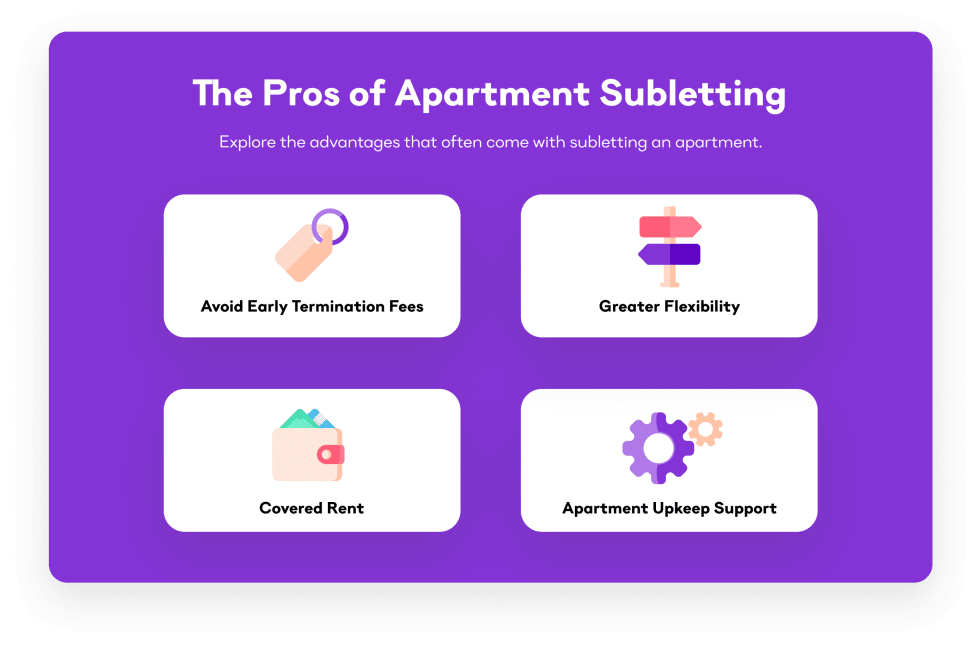
Subletting is generally best suited for temporary situations. If you need out of your lease permanently, a transfer or early termination may be the better option. If you choose to sublet, protect yourself with a strong legal agreement, do a proper screening, and ensure you get your landlord’s written approval.
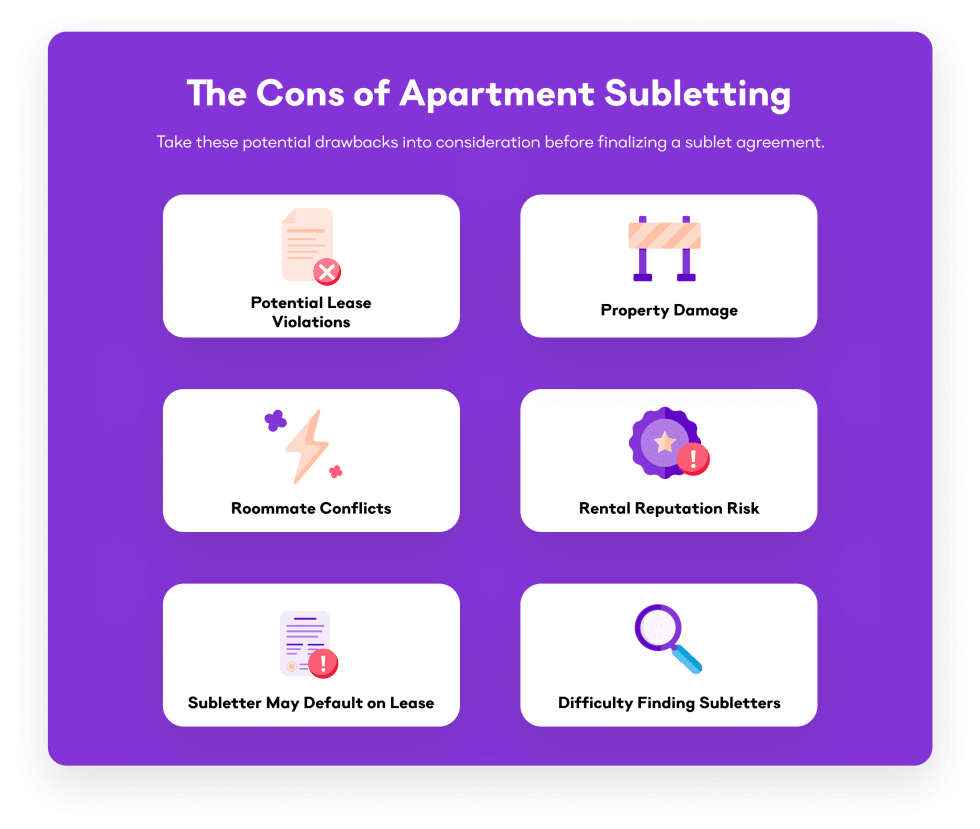
With more sublets advertised online and through social media, housing scams have become increasingly common. Protect yourself by recognizing the red flags and taking the right precautions.
Be Wary Of:
Stay Safe By:
A little caution goes a long way. By staying alert to red flags and sticking to trusted platforms, you can avoid costly scams and make sure your sublet is a safe, legal arrangement.
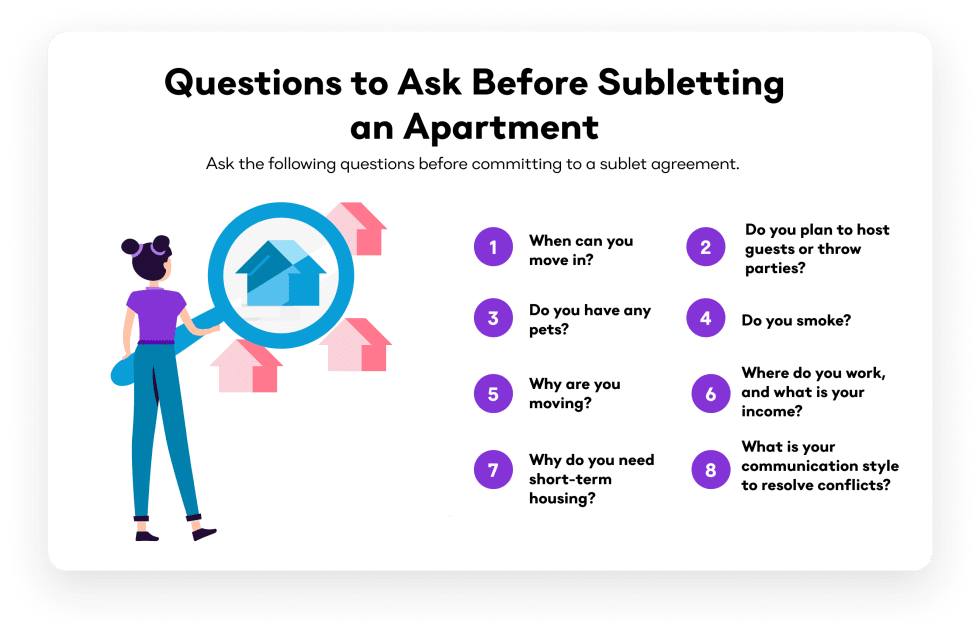
Use your landlord’s template if they have one, or download a vetted digital form. If your landlord doesn’t have a standard sublease agreement template, it’s wise to ask a lawyer to review it before signing anything. Your sublease agreement should include the following:
Laying out the details clearly in writing sets you up for a smooth sublease. Still, subletting isn’t right for every renter. Here are some alternatives that might be a better fit.
If subletting doesn’t feel like the right fit, you still have options.
When it comes to subletting, weigh the costs and benefits carefully to find the option that best fits your situation.
Now that you know how subletting works, you can decide if it’s the right move for you. If you’re ready for a fresh start, Apartment List makes it simple to compare rentals and find a place that fits your lifestyle. Take our quiz to get matched with your dream apartment.
A subletting clause is a section in your lease that explains whether subletting is allowed. Some leases ban it outright, while others allow it with landlord approval. Always check this clause before making plans.
Look for clear photos, accurate details, and the option to tour in person or virtually. Avoid anyone who asks for money up front, refuses to provide proof of lease, or won’t meet directly.
Some signs of a subleasing scam include:
If your lease and local laws permit subletting, you’ll still need written approval. Start by reviewing your lease, then notify your roommates of your plans. Screen potential subtenants and draft a sublease agreement. Finally, send your landlord a written request with the subtenant’s details and sublease term, and wait for approval before signing.
Subletting rules depend on your lease and local or state laws. Always check your lease first and confirm with your landlord before arranging a sublet.
A sublease is illegalif it violates your lease terms or local laws, or if it’s done without your landlord’s consent. Illegal subletting can result in eviction or financial liability, so it’s essential to get approval and follow the rules.
Keep questions lease-related, and avoid overly personal topics that may make someone uncomfortable.
Yes. If your lease bans subletting or your landlord finds your subtenant unqualified, they can deny it. If your lease allows subletting, providing a strong, well-screened candidate improves your chances.
In most cases, no. Many states, especially those with rent control laws, prohibit charging a subtenant more than your actual rent. Always check local regulations before setting a rental price.
You remain legally responsible for rent under your original lease. If the subtenant stops paying, your landlord can hold you accountable. To protect yourself, collect a security deposit and use a clear sublease agreement.
It depends on your lease and local laws. Many landlords only allow sublets for the remainder of your lease term. Always match your sublease end date to your lease unless your landlord agrees otherwise.
A sublet request letter should include your contact information, the property address, your intention to sublet, the sublease term, the subtenant’s name, and your forwarding address. Send it by email or certified mail to keep a record.
In a sublet, your name stays on the lease and you remain responsible while another renter lives in the unit. In a lease assignment (or transfer), the landlord approves a new tenant who takes over your lease, usually releasing you from further responsibility.
A reletting fee is different from a break lease fee and may apply if you end your lease early and the landlord has to find a new tenant. With a sublet, you stay on the lease and usually avoid reletting fees, since you’re still responsible for rent.




In unit laundry, Patio / balcony, Granite counters, Pet friendly, Stainless steel, Walk in closets + more
In unit laundry, Hardwood floors, Dishwasher, 24hr maintenance, Stainless steel, Walk in closets + more